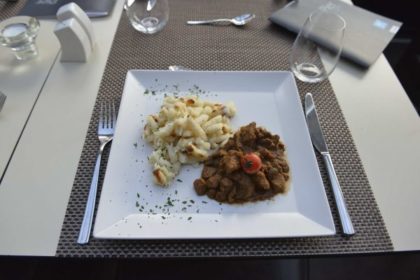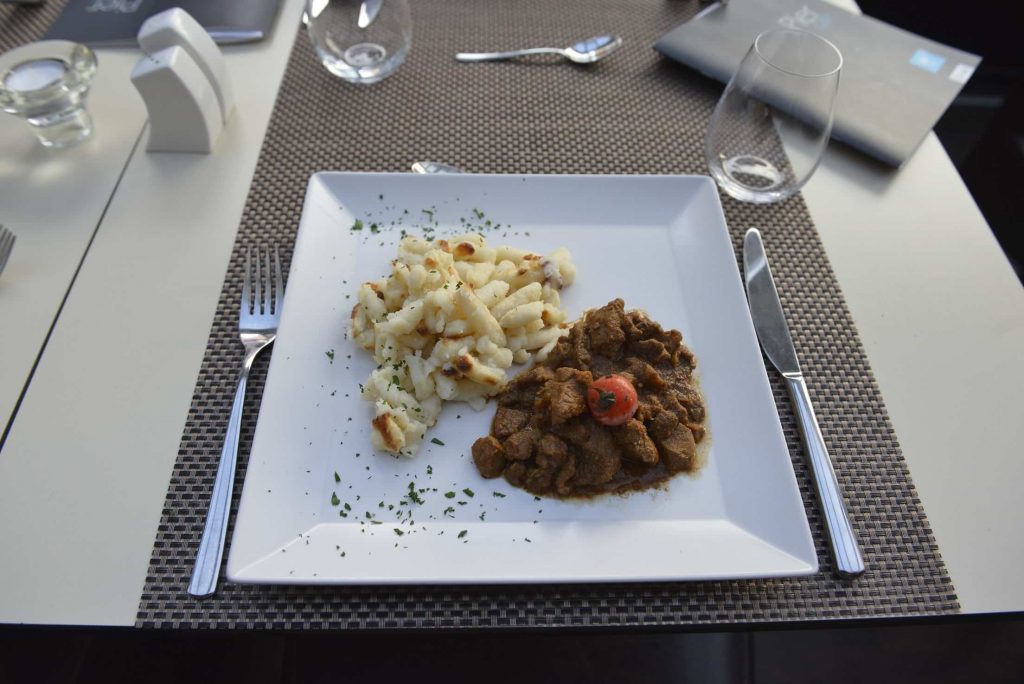

CONTACT US
1052 Budapest, Jane Haining Quay, Dock 11.
Customer support is available daily from 9:00 to 22:00.
Budapest, Jane Haining Quay, Dokk 11, 1052

 Much Hungarian food is considered to be greasy and contains some red pepper (paprika). The Beef stew (pörkölt) is a common example of Hungarian cuisine. From the 1780s, it has been mentioned as a typical dish of the shepherds in the Great Plain which had to contain some smoked and crushed red pepper. For a long time, the stew was looked down as it was thought to be the peasants’ food. However, in the next two centuries, it became popular among the more elite groups of the society, too. Then it was known as holiday food; for example, it was often served on Sundays or at weddings. Sometimes, especially during family events, the stew is made in a cauldron – as the shepherds did centuries ago. This method is quite spectacular and gives a special characteristic taste to the food.
Much Hungarian food is considered to be greasy and contains some red pepper (paprika). The Beef stew (pörkölt) is a common example of Hungarian cuisine. From the 1780s, it has been mentioned as a typical dish of the shepherds in the Great Plain which had to contain some smoked and crushed red pepper. For a long time, the stew was looked down as it was thought to be the peasants’ food. However, in the next two centuries, it became popular among the more elite groups of the society, too. Then it was known as holiday food; for example, it was often served on Sundays or at weddings. Sometimes, especially during family events, the stew is made in a cauldron – as the shepherds did centuries ago. This method is quite spectacular and gives a special characteristic taste to the food.
’Pörkölés’ (roasting) is the name of a special trick of the Hungarian cuisine. The meat is chopped then it is cooked in some pork fat seasoned with some onion. It had to be blend until it loses its fluid content. Finally, it’s seasoned with some red pepper and – after giving some water to it – you should steam it for a while.
 What are the most important ingredients?
What are the most important ingredients?Amount of the onion is a cardinal question which can cause serious arguments among both professional and hobby chefs. One onion is enough for every kg of meat. However, some people can put extreme quantities into the stew! The origin of this bad habit comes back to the caserns in the Austro-Hungarian Monarchy. Chefs there wanted to solve cooking as cheap as possible so they used incredible amounts of onions. The original version of the Hungarian stew contains only fat, onion, and meat, and it’s seasoned with red pepper and salt. Nowadays, meat is usually red meat like beef, sheep, or pork. It is recommended mixing the different types of meat such as neck and sirloin. Gourmets can put some inmeats into the stew or use some game such as rabbit, boar, or deer. There is a kind of stew which is rather common in the folk cuisine but foreigners usually consider it is frightening. Don’t follow their example! Forget the stereotypes and give a chance to the rooster testicle stew.
If you choose a good-quality red wine to the stew, you can’t make a mistake. Egri Bikaver is an absolutely perfect choice!
It depends on the type of meat and – of course – your individual taste, but the most common side dishes are the followings: cooked potatoes, egg barley, or noodles. Sometimes pickled cucumber as a salad is also served with the stew. Its slightly sour taste is in great harmony with the meat, onion, and red pepper.
Onion mustn’t be substituted with garlic which has too characteristic taste! Although oil is worthly considered to be healthier than pork fat, a good stew needs fat because it dissolves red pepper better. For the same reason, use greasy meat. A traditional Hungarian stew doesn’t require pepper or other special spices.
 Let’s see two close relatives: the goulash (’gulyás’) and the paprikash
Let’s see two close relatives: the goulash (’gulyás’) and the paprikashActually, these dishes are not real Hungarian stew but they have several similar features. Paprikash is only cooked so the phase of baking on fat (‘pörkölés’) is missing. It is often served with some sour cream but it’s not essential. Originally, it is made from white-meated animals such as chicken or turkey. In the goulash, onion is not as dominant as in the stew, and most kinds of it contain lots of fluid but less than an average soup. Beef goulash is the original and still most common type. If you make it, you have to put every ingredient into a pot and cook them together. Fish soup is another far relative of goulash; their cooking methods have many similarities.
All of these dishes contain more or less red pepper. Nowadays, most of the restaurants don’t make them too hot. Instead, there is some spice on the guests’ table so fans of strong tastes can put some extra red pepper into the food.